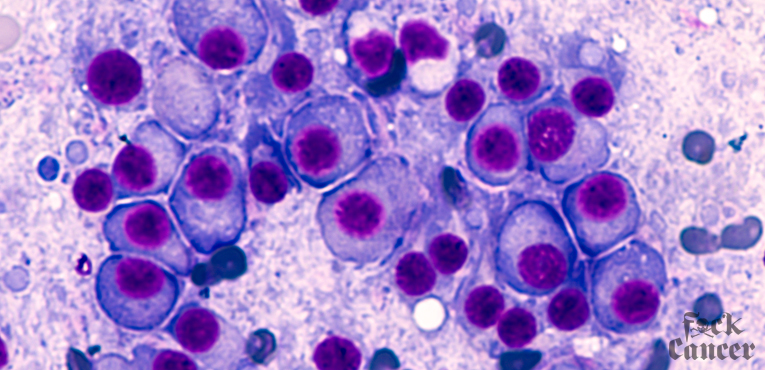
What Is Multiple Myeloma?
Cancer starts when cells begin to grow out of control. Cells in nearly any part of the body can become cancer, and can spread to other areas.
Multiple myeloma is a cancer of plasma cells. Normal plasma cells are found in the bone marrow and are an important part of the immune system. The immune system is made up of several types of cells that work together to fight infections and other diseases. Lymphocytes (lymph cells) are one of the main types of white blood cells in the immune system and include T cells and B cells. Lymphocytes are in many areas of the body, such as lymph nodes, the bone marrow, the intestines, and the bloodstream.
When B cells respond to an infection, they mature and change into plasma cells. Plasma cells make the antibodies (also called immunoglobulins) that help the body attack and kill germs. Plasma cells, are found mainly in the bone marrow. Bone marrow is the soft tissue inside bones. In addition to plasma cells, normal bone marrow is also the home for other blood cells such as red cells, white cells, and platelets.
In general, when plasma cells become cancerous and grow out of control, this is called multiple myeloma. The plasma cells make an abnormal protein (antibody) known by several different names, including monoclonal immunoglobulin, monoclonal protein (M-protein), M-spike, or paraprotein.
There are, however, other plasma cell disorders that also have abnormal plasma cells but do not meet the criteria to be called active multiple myeloma. These other plasma cell disorders include:
- Monoclonal gammopathy of uncertain significance (MGUS)
- Smoldering multiple myeloma (SMM)
- Solitary plasmacytoma
- Light chain amyloidosis.
Multiple myeloma features
Low blood counts
In multiple myeloma, the overgrowth of plasma cells in the bone marrow can crowd out normal blood-forming cells, leading to low blood counts.
- This can cause anemia (a shortage of red blood cells). People with anemia become weak and fatigued.
- Multiple myeloma can also cause the level of platelets in the blood to become low (called thrombocytopenia). This can lead to increased bleeding and bruising.
- Another condition that can develop is leukopenia (a shortage of normal white blood cells). This can lead to problems fighting infections.
Bone and calcium problems
Myeloma cells also interfere with cells that help keep bones strong. Bones are constantly being remade to keep them strong. Two kinds of bone cells work together to keep bones healthy and strong:
- Osteoclasts break down old bone
- Osteoblasts lay down new bone
Myeloma cells make a substance that tells the osteoclasts to speed up dissolving the bone. So old bone is broken down without new bone to replace it, making the bones weak and easy to break. Fractured bones are a major problem in people with myeloma. This increase in bone break-down can also raise calcium levels in the blood. Problems caused by high calcium levels are discussed in Signs and Symptoms of Multiple Myeloma.
Infections
Abnormal plasma cells cannot protect the body from infections. As mentioned before, normal plasma cells produce antibodies that attack germs. In multiple myeloma, the myeloma cells crowd out the normal plasma cells, so that antibodies to fight the infection can’t be made. The antibody made by the myeloma cells does not help fight infections. That’s because the myeloma cells are just many copies of the same plasma cell – all making copies of the same exact (or monoclonal) antibody.
Kidney problems
Myeloma cells make an antibody that can harm the kidneys, leading to kidney damage and even kidney failure.
Other Plasma Cell Disorders
Monoclonal gammopathy
A monoclonal gammopathy is when plasma cells make too many copies of the same antibody. It is usually found on a routine blood test when looking for other conditions. Although people with multiple myeloma have a monoclonal gammopathy, not everyone with monoclonal gammopathy has multiple myeloma. It can also occur in other diseases, such as Waldenstrom macroglobulinemia and some lymphomas. It can also occur in a disorder known as monoclonal gammopathy of undetermined significance (MGUS), which does not cause problems like multiple myeloma does. However, some people with MGUS will eventually go on to develop multiple myeloma or other diseases.
Monoclonal gammopathy of undetermined significance
In monoclonal gammopathy of undetermined significance (MGUS), abnormal plasma cells make many copies of the same antibody (called a monoclonal protein). However, these plasma cells do not form an actual tumor or mass and do not cause any of the problems seen in multiple myeloma. MGUS usually does not affect a person’s health. It doesn’t cause weak bones, high calcium levels, kidney problems, or low blood counts. It’s most often found when a routine blood test finds a high level of protein in the blood and further testing shows the protein is a monoclonal antibody. In MGUS, the number of plasma cells may be increased, but they still make up less than 10% of the cells in the bone marrow.
MGUS is not considered cancer, but it is sometimes called pre-malignant because some people with MGUS will eventually develop cancers such as multiple myeloma, lymphoma, or amyloidosis. Each year, about 1% of people with MGUS develops one of these diseases. The risk is higher in people whose protein levels are particularly high. Patients with MGUS don’t need treatment, but they are watched closely to see if they get a disease that does need to be treated, such as multiple myeloma.
Solitary plasmacytomas
A plasmacytoma is a type of abnormal plasma cell growth that is cancerous. Rather than many tumors in different locations as in multiple myeloma, there is only one tumor, hence the name solitary plasmacytoma.
A solitary plasmacytoma often develops in a bone. When a plasmacytoma starts in other tissues (such as the lungs or other organs), it is called a solitary extramedullary or extraosseous plasmacytoma. Solitary plasmacytomas are most often treated with radiation therapy. Sometimes surgery may be used. As long as no other plasmacytomas are found later on, the patient’s outlook is usually excellent. However, since many people with a solitary plasmacytoma will develop multiple myeloma, these people are watched closely for signs of this disease.
Smoldering multiple myeloma (SMM)
Smoldering multiple myeloma (SMM) is an early or asymptomatic (no symptoms) myeloma that is not causing any problems. People with smoldering myeloma have some signs of multiple myeloma, such as any of the following:
- A large amount of plasma cells in the bone marrow
- A high level of monoclonal immunoglobulin (monoclonal protein) in the blood
- A high level of light chains (small protein segments also called Bence Jones protein) in the urine.
But, they have normal blood counts, normal calcium levels, normal kidney function, no bone or organ damage, and no signs of amyloidosis.
People with smoldering multiple myeloma do not need treatment right away, because the disease can take anywhere from many months to years to become active (symptomatic) myeloma. Some people may have very slow disease that never becomes active myeloma. SMM is an area of active research. There are SMM that have high risk features that put them at a greater chance of turning into active myeloma and studies are being done to see if they should be reclassified as “active” myeloma or if they should start treatment sooner. People with SMM are also watched closely for signs of myeloma.
Light chain amyloidosis
Light chain amyloidosis is also a disorder of abnormal plasma cell growth, but with lower amounts of abnormal plasma cells in the bone marrow compared to multiple myeloma.
Monoclonal proteins (antibodies) are made up of joined protein chains – 2 short light chains and 2 longer heavy chains. In light chain amyloidosis, abnormal plasma cells make too many light chains which are shorter and weigh less than the heavy chains. The light chains build up in tissues as an abnormal protein known as amyloid.
The buildup of amyloid in certain organs can enlarge them and affect the way they work. For example, when amyloid builds up in the heart, it can cause an irregular heart beat and cause the heart to enlarge and get weaker. A weak heart can lead to a condition called congestive heart failure, with symptoms like shortness of breath and swelling in the legs. Amyloid in the kidneys can cause them to work poorly. This may not cause symptoms early on, but the poor kidney function may be found on blood tests. If it gets worse, it can lead to kidney failure. See Signs and Symptoms of Multiple Myeloma.
Other names for light chain amyloidosis include AL and primary amyloidosis.
Light chain amyloidosis is only one of the diseases where amyloid builds up and causes problems. Amyloidosis can also be caused by a genetic (hereditary) disease called familial amyloidosis. Long-standing (chronic) infection and/or inflammation can also cause amyloidosis. This is known as secondary or AA amyloidosis. These other kinds of amyloidosis are not covered here.
Waldenstrom macroglobulinemia (WM)
The cancer cells in people with WM are similar to those of multiple myeloma and non-Hodgkin lymphoma(NHL). Multiple myeloma is considered a cancer of plasma cells, and non-Hodgkin lymphoma is a cancer of lymphocytes. WM cells have features of both plasma cells and lymphocytes.
WM cells make large amounts of a certain type of antibody (immunoglobulin M, or IgM), which is known as a macroglobulin. Each antibody (protein) made by the WM cells is the same, so it is called a monoclonal protein, or just an M protein. The buildup of this M protein in the body can lead to many of the symptoms of WM, including excess bleeding, problems with vision, and nervous system problems. Even though WM has a monoclonal gammopathy and is sometimes grouped into other plasma cell disorders, it is considered a type of NHL. Another name for WM is lymphoplasmacytic lymphoma. Treatment for WM includes drugs used to treat multiple myeloma and NHL.
Key Statistics About Multiple Myeloma
Multiple myeloma is a relatively uncommon cancer. In the United States, the lifetime risk of getting multiple myeloma is 1 in 132 (0.76%).
The American Cancer Society’s estimates for multiple myeloma in the United States for 2020 are:
- About 32,270 new cases will be diagnosed (17,530 in men and 14,740 in women).
- About 12,830 deaths are expected to occur (7,190 in men and 5,640 in women).
fuck cancer, f cancer, fuck cancer foundation, fxck cancer foundation, cancer awareness, cancer prevention, cancer detection, cancer education, multiple myeloma, myeloma
Source: American Cancer Society, About Multiple Myeloma, https://www.cancer.org/cancer/multiple-myeloma/about/what-is-multiple-myeloma.html, December 7, 2017
